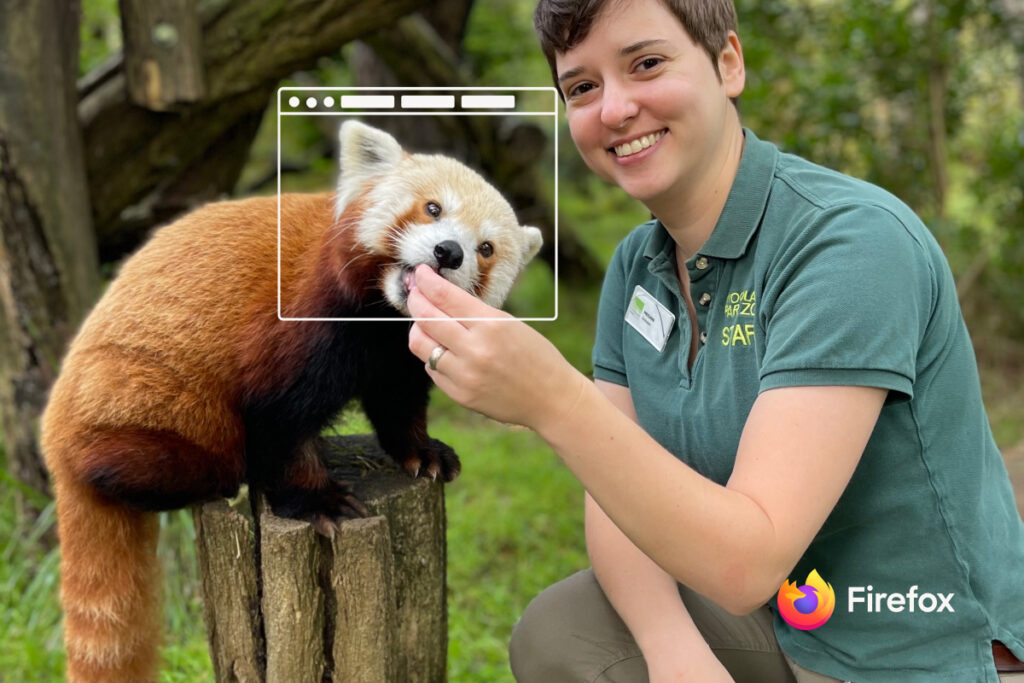Firefox IRL: Meet Seattle’s Carson, the Woodland Park Zoo’s feisty red panda

Did you know that the red panda is also known as a firefox? Sept. 16 is International Red Panda Day, so we thought it would be a good time to visit a Firefox, ahem red panda, in real life and talk to their caretakers at zoos across the U.S. See our full series of interviews here.
Situated in the Pacific Northwest, the Woodland Park Zoo in Seattle offers a temperate forest that provides cooler temperatures where animals like the red panda can thrive. There, you’ll meet Carson, an 8-year-old red panda.
Carson’s caretaker is Megan Blandford, the animal keeper at the Woodland Park Zoo. Megan describes Carson’s personality as feisty, and from what we’ve heard, you can either find him looking for food scraps or napping at the top of his tree. We love naps, too!
We caught up with Megan where she tells us more about Carson, shares her first foray in the zoo world (you’ll never guess, it involved building a piano for a killer whale) and how caring for a red panda provides job security.
Tell us about the red pandas you care for:
“…currently has one 8-year-old Himalayan red panda named Carson that you can see daily in Woodland Park Zoo’s temperate forest [habitat]. He’s got a very feisty personality and never hesitates to let you know his strong opinions and feelings about things. He will move heaven and earth for a few bites of grapes and apples, and is sure to assist the keepers every afternoon when we aren’t giving him his daily allotment of bamboo fast enough. When he’s not cruising around on the ground for potentially missed food scraps, you can usually find him curled up in his favorite snooze spot towards the top of the tree in front of his exhibit.”

What’s the coolest part about working with red pandas?
“There are so many great things about working with red pandas that it’s hard to say what the best part is! I think personally my favorite part is when Carson sees me first thing in the morning and gets SO excited. He will run along the fence to greet me and is equally excited to come in and eat/train when I come back over a few minutes later. Fun fact! Picture what you would imagine a unicorn sounds like, and that’s one of the primary vocalizations the red pandas make. It’s like an extremely high-pitched rapid neighing. I also love being able to do keeper talks and talk to the public about them and how special they are, and let them know that there are actions that they can take to help protect these unique animals that are endangered in the wild.”
How did you get your start as a zookeeper?
“I’ve been an animal keeper since 2011 and have been working with red pandas since 2020. When I was in college, I initially wanted to become a veterinarian but learned through my university that I HATED performing surgery and needed to change my goals. After working in a herpetology and parrot cognition lab on campus, I thought I might try my hand at zookeeping. I first dipped my toe into the zoo world as an intern at Six Flags Discovery Kingdom in California, where I produced ideas and then built enrichment items for an orca they had at the time (I ended up working with an engineering team to build a Simon-says killer whale piano for her.) It can be very competitive to break into the zoo world, so after I graduated and was unable to land another zoo internship or job, I worked as a freelance photographer specializing in human rights violations in Africa, specifically the Gambaga outcast witch colony and the black markets around Ghana. When I got back to the U.S. I was lucky enough to get a full-time internship in Toledo, Ohio working with elephants. From there I was hired on, and the rest is history. I eventually started working at Woodland Park Zoo; the red pandas are always the highlight of my day.”
What does your typical day look like?
“My typical day starts with life checking all the animals on my unit to make sure no one had any issues overnight (e.g. HVAC going out, branch falling on a fence, tragically uninformed mallards wandering into predator areas, etc), which for me includes the maned wolves, red pandas, southern pudu and jaguars. Then I’ll prep their diets in the morning and start their morning feedings. After everyone is happy and satiated, I’ll start cleaning, and red pandas make up a large part of that because red pandas defecate a lot! Like, an alarming amount if you aren’t expecting it. Their diets consist of lots of items like bamboo that are very low in nutritional value and take lots of energy to digest. As a result, they both sleep and poop a staggering amount. If you imagine the amount a typical golden retriever might produce in a day, each red panda produces about five times as much as that per day, it’s fantastic job security. I’ll also train all the animals throughout the day so that they can participate in their own husbandry and veterinary care; it allows us the flexibility to give them choice and control regarding their care. For example, we do voluntary blood draws on Carson every few months. The male red panda is trained to sit on a platform and is reinforced with his favorite snacks while our talented veterinary staff draw blood from his tail. He’s great at other behaviors as well, like allowing voluntary injections and standing on a scale to obtain his weight. After feeding, training and cleaning, I then start to feed out their diets for overnight and check on them one last time (I like to think of it as tucking them in) before leaving for the day.”
Thank you, Megan, for sharing your stories about being a zookeeper and Carson. One of these days we’ll have to get an audio recording of Carson doing his impression of a unicorn with his “extremely high-pitched rapid neighing.”


